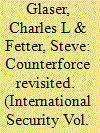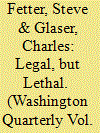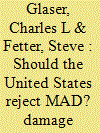| Srl | Item |
| 1 |
ID:
067209


|
|
|
| 2 |
ID:
183649


|
|
|
|
|
| Summary/Abstract |
North Korea has made significant strides in its attempt to acquire a strategic nuclear deterrent. In 2017, it tested intercontinental ballistic missiles (ICBMs) and completed a series of nuclear test explosions. These may provide North Korea with the technical foundation to deploy a nuclear-armed ICBM capable of striking the United States. The Ground-based Midcourse Defense (GMD) missile defense system is intended to deter North Korean nuclear coercion and, if deterrence fails, to defeat a limited North Korean attack. Despite two decades of dedicated and costly efforts, however, the GMD system remains unproven and unreliable. It has not demonstrated an ability to defeat the relatively simple and inexpensive countermeasures that North Korea can field. The GMD system has suffered persistent delays, substantial cost increases, and repeated program failures because of the politically motivated rush to deploy in the 1990s. But GMD and other U.S. missile defense efforts have provoked serious concerns in Russia and China, who fear it may threaten their nuclear deterrents. Diplomacy and deterrence may reassure Russia and China while constraining North Korea's nuclear program. An alternate airborne boost-phase intercept system may offer meaningful defense against North Korean missiles without threatening the Russian or Chinese deterrents.
|
|
|
|
|
|
|
|
|
|
|
|
|
|
|
|
| 3 |
ID:
157474


|
|
|
|
|
| Summary/Abstract |
Terrorists could acquire nuclear weapons by using weapon-usable nuclear material that was stolen or otherwise diverted from legitimate authorities. Multiple well-documented seizures suggest the existence of a black market that draws on an unknown stock of weapon-usable nuclear material that is not under the control of authorities. We estimate the total amount of uncontrolled material based on publicly reported seizures and several different statistical methods and models. We estimate that 90 to 250 kilograms--sufficient for up to ten nuclear weapons--remain outside the control of legitimate authorities. While this estimate is subject to large uncertainties and potential bias, governments may have additional information about nuclear material seizures that could be used to improve estimates.
|
|
|
|
|
|
|
|
|
|
|
|
|
|
|
|
| 4 |
ID:
065420


|
|
|
| 5 |
ID:
186374


|
|
|
|
|
| Summary/Abstract |
Starting around a decade or so ago, the law of armed conflict (LOAC) acquired new prominence in the development of US nuclear strategy. This was stimulated in part by a series of major intergovernmental conferences on the humanitarian impact of nuclear weapons, which led to a consensus among a group of nations that the use of nuclear weapons would result in catastrophic and unacceptable human suffering and was therefore incompatible with the LOAC.1 This argument has been a key rationale for efforts to prohibit nuclear weapons, including the 2017 Treaty on the Prohibition of Nuclear Weapons (TPNW), which as of early 2022 had 86 signatories and 59 states parties.
|
|
|
|
|
|
|
|
|
|
|
|
|
|
|
|
| 6 |
ID:
162102


|
|
|
| 7 |
ID:
174620


|
|
|
|
|
| Summary/Abstract |
In 2016 and 2017, North Korea demonstrated a range of technologies that brought it much closer to deploying an intercontinental ballistic missile (ICBM). After the November 2017 test of the Hwasong-15 missile, Kim Jong Un declared that North Korea has “finally realized the great historic cause of completing the state nuclear force” and is now immune to American nuclear blackmail and coercion.
|
|
|
|
|
|
|
|
|
|
|
|
|
|
|
|
| 8 |
ID:
147046


|
|
|
|
|
| Summary/Abstract |
As China invests in its nuclear forces and U.S.-China relations become increasingly strained, questions of U.S. nuclear doctrine require greater attention. The key strategic nuclear question facing the United States is whether to attempt to maintain and enhance its damage-limitation capability against China. The answer is less straightforward than it was during the Cold War, because China's nuclear force is orders of magnitude smaller than the Soviet force was. Part of the answer depends on the military-technical feasibility of the United States achieving a significant damage-limitation capability: What would be the outcome of military competition over the survivability of China's intercontinental ballistic missiles, submarine-launched ballistic missiles, and command and control, and over the effectiveness of U.S. ballistic missile defenses? The answer also depends on the benefits that a damage-limitation capability would provide; these could include contributions to homeland deterrence, extended deterrence, and reassurance of U.S. regional allies. The final piece of the analysis concerns the potential costs of a damage-limitation capability, which could include increased escalatory pressures during crises and growing political tension between the United States and China. A thorough analysis demonstrates that the United States should forgo such a capability because the prospects for preserving a significant damage-limitation capability are poor; the deterrent benefits would be small; and the escalatory and political costs would be relatively large.
|
|
|
|
|
|
|
|
|
|
|
|
|
|
|
|
| 9 |
ID:
039063


|
|
|
|
|
| Publication |
Cambridge, Ballinger Publishing Company, 1988.
|
| Description |
xvii, 206p.
|
| Standard Number |
0887302815
|
|
|
|
|
|
|
|
|
|
|
|
Copies: C:1/I:0,R:0,Q:0
Circulation
| Accession# | Call# | Current Location | Status | Policy | Location |
| 030937 | 327.174/FET 030937 | Main | On Shelf | General | |
|
|
|
|